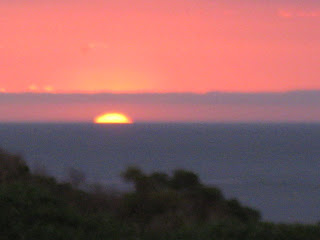
























Rather than battle the strong south-westerly gale whipping along the beach, we chose instead to drive 5 km to Swan Lake and do a bush walk.
The 1 km long Swan Lake walking track winds its way through dense coastal vegetation; consequently, it is an ideal place to be when it's windy. Banksias, eucalypts, tea- tree and melaleuca create a tunnel effect over and around the track. Not a breath of wind disturbs the peace.
Underfoot are deep layers of leaf litter and sand. Pussytail grasses and other native grasses whisper their softness beneath the tree canopy. New Zealand spinach drapes itself artistically over low hanging banksia branches, creating a cave-like hollow. Nature plaques give visitors information about the ecology of the area.
The final part of the track is an extensive boardwalk that passes over a melaleuca swamp, and then goes through a mutton bird rookery towards three bird hides overlooking the Swan Lake wetlands.
Since 2011 was exceptionally wet on the island, Swan Lake is full of water and rich with animals, birds and insects -- with waterbirds in particular flocking to the area.
An attractive and informative mural painted on a wall in one of the bird hides shows the many different species seen at Swan Lake. We saw black swans with well grown cygnets, water hens and many duck species sitting on the far bank. Unfortunately we forgot to take our binoculars. A swamp wallaby had a drink from the edge of the lake and then hopped away into the dunes.
The Swan Lake mutton bird rookery is dense with burrows -- within each burrow, an adult bird is incubating a large single egg, due to hatch around 15 January.
Even though it was Boxing Day the only people we saw were a young Japanese couple. Swan Lake and the surrounding coastal vegetation is cared for by the Phillip Island Nature Park, who do a fantastic job in caring for the unique vegetation, animals and birds that live on and around Phillip Island.
The Swan Lake bush walk gave me an experience of a wonderland. It's the best held secret on this island!




















































